By Marc W. Herold
(5-) 76-91 civilians killed (61 children, 15 women, 15 men) including:
| 91 victims' names | Father's name | Age | Sex |
| Abdul Raza | Lal Muhammad Khan | 45 | Male |
| Tahir | Shahnawaz Khan | 38 | Male |
| Borjan | Shahnawaz Khan | 82 | Male |
| Habib | Muhammad Ghaus | 76 | Male |
| Noor Muhammad | Dost Muhammad | 82 | Male |
| Abdul Rashid | Muhammad | 40 | Male |
| Muhammad | Saedo Khan | 30 | Male |
| Sher Ahmad | Mubeen | 35 | Male |
| Subhat | Khuda-ul-Rahim | 50 | Male |
| Abdul Zahir | Driver | 40 | Male |
| Muhammad Ali | Mir Afghan | 90 | Male |
| Muhammad Khan | Muhammad Ali | 50 | Male |
| Muhammad Lal | Muhammad Ali | 40 | Male |
| Bahawal Haq | Abdul Karim | 60 | Male |
| Abdul Aleem | Muhammad Khan | 18 | Male |
| Wife of Raza | Muhammad Ali | 30 | Female |
| Wife of Taimur Shah | Baab-ul-uddin | 32 | Female |
| Wife of Tahir | Mullah Ghani | 31 | Female |
| Wife of Borjan | - | 73 | Female |
| Paiki | Borjan | 17 | Female |
| Suraya | Golo Khan | 32 | Female |
| Sameera | Gul Agha | 25 | Female |
| Shireen | Mullah Mannan | 60 | Female |
| Zulaikha | Noor Muhammad | 35 | Female |
| Bari Gul | Noor Muhammad | 22 | Female |
| Wife of Saedo Khan | - | 27 | Female |
| Gulrukh | Bor Khan | 30 | Female |
| Wife of Saat | Musa Khan | 25 | Female |
| Mother of Muhammad Amin | Abdullah | 60 | Female |
| Wife of Baab-ul-uddin | - | 50 | Female |
| Seya Mo | Reza Khan | 14 | Female |
| Sameera | Reza Khan | 8 | Female |
| Saeed Ahmad | Reza | 6 | Female |
| Arzoo | Taimur Shah | 12 | Female |
| Roma | Taimur Shah | 10 | Female |
| Kibra | Taimur Shah | 8 | Female |
| Roya | Taimur Shah | 5 | Female |
| Aman | Taimur Shah | 8 mos | Male |
| Maldar | Gul Ahmad | 15 | Female |
| Saleem | Muhammad Tahir | 8 | Male |
| Sakeena | Gul Ahmad | 18 | Female |
| Naseema | Gul Ahmad | 8 | Female |
| Muhammad Arif | Momin | 7 | Male |
| Muhammad Asif | Momin | 5 | Male |
| Fareba | Jan Agha | 5 | Female |
| Negina | Jan Agha | 2 | Female |
| Mir Agha | Daud | 14 | Male |
| Muhammad Agha | Daud | 15 | Male |
| Ghulam Siddique | Daud | 1 | Male |
| Aqila | Daud | 7 | Female |
| Sakeena | Daud | 5 | Female |
| Shakeela | Daud | 3 | Female |
| Omaid | Suhoolat | 3 | Male |
| Durrani | Suhoolat | 7 | Male |
| Gulalai | Suhoolat | 5 | Female |
| Jan Sher | Shah Alam | 16 | Male |
| Khuda Dad | Habeeb | 9 | Male |
| Nabi Jan | Noor Muhammad | 10 | Male |
| Taza Gul | Noor Muhammad | 3 | Male |
| Maida Gul | Noor Muhammad | 2 | Female |
| Zia Gul | Noor Muhammad | 1 | Female |
| Saeed Bibi | Bari Gul | 6 mos | Female |
| Sher Ahmad | Bari Gul | 3 | Male |
| Bibi Gul | Muhammad Alam | 4 | Female |
| Shafiqa | Sardar | 2 | Female |
| Bashar | Abdul Rashid | 7 | Male |
| Son of | Abdul Rashid | 10 | Male |
| Son of | Abdul Rashid | 3 | Male |
| Son of | Abdul Rashid | 8 | Male |
| Daughter of | Abdul Rashid | 12 | Female |
| Daughter of | Abdul Rashid | 5 | Female |
| Daughter of | Saedo Khan | 9 | Female |
| Son of | Saedo Khan | 4 | Male |
| Daughter of | Saedo Khan | 7 | Female |
| Ghani Jan | Abdul Hakeem | 7 | Male |
| Rahima | Abdul Hakeem | 3 | Female |
| Shafi | Abdul Hakeem | 4 mos | Male |
| Son of | Subhat | 8 | Male |
| Daughter of | Subhat | 5 | Female |
| Gul Ghotay | Subhat | 10 | Female |
| Akhtar Muhammad | Muhammad Lal | 6 | Male |
| Khudai Rahim | Muhammad Lal | 3 | Male |
| Qamar Gul | Muhammad Lal | 10 | Female |
| Zuhra Gul | Muhammad Lal | 5 | Female |
| Wakeel Ahmad | Amanullah | 8 | Male |
| Nazaneen | Muhammad Khan | 8 | Female |
| Rahim Gul | Khan | 9 | Male |
| Ibrahim | Khan | 12 | Male |
| Ismatullah | Farooq | 13 | Male |
| 6 yr old girl who died later | n.a. | 6 | Female |
Wounded:
| Name | Father’s Name | Sex |
| Abdul Ghafoor | Fazil-ul-haq | Male |
| Siddiqa | Abdul Hamid | Female |
| Saleema | Abdul Hamid | Female |
| Baran Shah | Muhammad Khan | Male |
| Abdul Waali | Muhammad Khan | Male |
| Habiba | Abdul Hamid | Female |
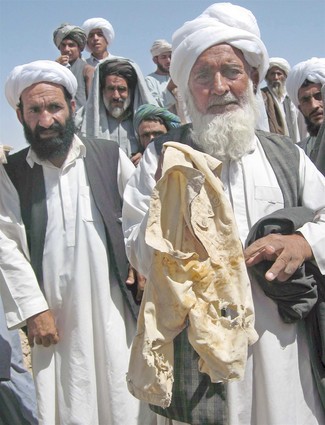
An Afghan man shows a shirt of a child who he said was killed in a U.S.-led coalition airstrike in western Herat province, Afghanistan. (Jalil Rezayee / EPA)
Photo Gallery of US victims in Afghanistan
The Afghan Victim Memorial Project by Prof. Marc
Between 2 – 8 AM on August 22, 2008 in the village of Azizabad located 4 miles due east of the Shindand air base and due south of Herat city in Herat Province. A ground force led by U.S. Special Forces (7th Special Forces Group (Airborne) based in Shindand), allegedly came under fire as it approached the village, carrying out a midnight raid to allegedly apprehend a Taliban commander, Mullah Siddiq. The U.S. Special Forces called-in close air support and a fierce bombardment of the village ensued involving both ground and air fire (including from a US Air Force Special Operations AC-130 aerial gunship, Apache attack helicopters and Predator drones). The U.S. bombs struck a large gathering of people who had congregated in Azizabad to honor a local leader who had died months earlier. A resident, Fatima, 25, explained from her hospital bed in Herat, where she wept and cursed those who carried out the air strike. “We were holding a memorial service in our home,” she said, tears running down her face. “Suddenly the infidels attacked and I lost consciousness. When I came to, I was in hospital, and they told me that all of my family were dead and already buried. Was my two-year-old child a terrorist? Then am I not also a terrorist? Why did they let me live?” On Friday morning, Ghulam Azrat, 50, director of the middle school in Azizabad, said he collected 60 bodies after the bombing. He told the A.P. by phone, “We put the bodies in the main mosque. Most of these dead bodies were children and women. It took all morning to collect them.” National Public Radio’s Soraya Sarhaddi Nelson visited Azizabad and reported,
Abdul Rashid treads gently across the rubble that was once his uncle's home in Azizabad, Afghanistan. He spots a little girl's shoe, caked in dried blood. He picks it up and waves it angrily in a visitor's face. "Does this look like it fits a Taliban fighter?" Rashid says. Still clinging to the tiny shoe, Rashid takes a few more steps and picks up a torn woman's veil." Does this look like something the Taliban would wear? Can you believe it? This is what Afghanistan has become," Rashid says, his rage dissolving into tears. The tribal elder says he doesn't know how to help his clan come to terms with the attack by U.S. and Afghan forces on his village last Friday. He pages through a handwritten report that lists the names and ages of 91 dead, most of them relatives. Sixty were children, and at least 15 more were women, say U.N. and Afghan officials, who have gone to Azizabad to investigate the incident. Rashid says the latest victim, a 6-year-old girl, was buried the day before. Afghan officials say Rashid's neighborhood, which was the target of the military operation, was packed with visitors the morning of the attack. They were there to attend a memorial ceremony honoring his late brother [Timor Shah], a local strongman. Rashid says vats of meat, rice and potatoes were being prepared for the scores of mourners when the soldiers attacked.
The photo below (by Soraya Nelson) shows Multan, 15, in a prayer vigil in front of his brother-in-law’s grave killed in the assault upon Azizabad. Multan said the 22 year old had just gotten married a couple of weeks ago:
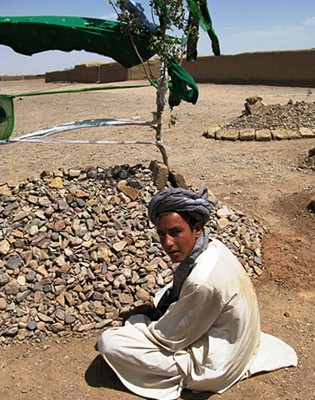
Nearby, a 27-year-old policeman named Daud wanders around in a tearful daze. He clings to a tattered piece of black cloth. It is part of the outfit he says his youngest daughter, aged 3, had on when she was killed, along with her five siblings and his wife. Daud says he was at a highway checkpoint far away when the soldiers and war planes came. Now, he doesn't know what he'll do. But he says one thing is for sure — he's quitting the force. He says he can no longer protect his country, not after his country failed to protect his family.
An angry survivor in Azizabad shouts anti-U.S. slogans in front of her destroyed home (photo by Fraidoon Pooyaa, A.P.):
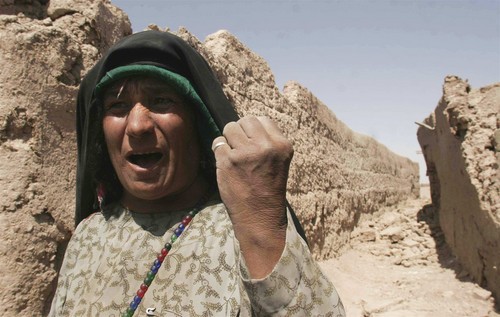
Gulbuddin, another resident told reporters from the Institute for War & Peace Reporting (IWPR), “Americans think all Afghans are terrorists and they send rockets and missiles against us. I myself buried more than 50 women and children. Are all of them terrorists?”
BBC Persia sent reporters to speak with residents of Azizabad. They reported speaking with villagers,
My name is Ahmad Shah Andiwal from Azizabad village. I am talking from the area, which was bombarded yesterday night. We will continue our protest until we get a clear answer because nothing is left for us’’. ‘’A man was killed a few months before and there was a religious ceremony for his death. But someone had reported to the Government officials that Taliban fighters were brought up to the village to attack the airport of Shindand district. I was there and I did not witness any Taliban fighters or Al Qaeda members.
Nur Ahmad, 55, was saved by a rescue team in Azizabad after being buried in rubble by the U.S. attack. He commented to IWPR,
The Taliban were better than this puppet government and its masters. The Taliban would at least distinguish between civilians and enemies. But these thugs think everybody is their enemy.
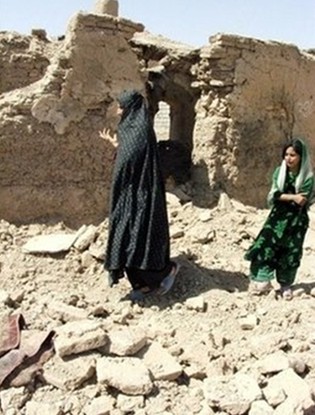

The Afghan Independent Human Rights Commission (AIHRC) said its investigators on-site concluded 91 people had perished: 59 children, 19 women and 13 men. Ahmad Nader Nadery, head of the AIHRC, said 76 of the victims belonged to one large extended family – that of Timor Shah’s brother who is named Reza. Reza was killed in the assault. Nadery confirmed reports from villagers that a memorial ceremony was being held for a deputy militia commander allied with the Afghan police named Timor Shah, who had died in a personal dispute several months ago. Because of the memorial, relatives and friends from outside Azizabad were staying overnight in village homes, he said. Government officials who travelled to the village of Azizabad in Herat province said the death toll had risen to 95 from 76, making it one of the deadliest bombing strikes on civilians in six years of war.
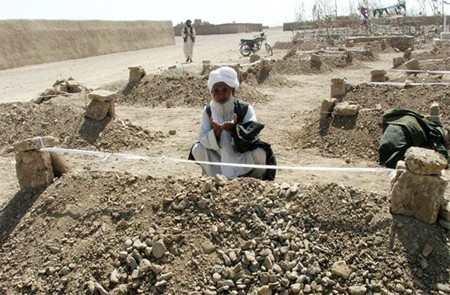
More photos
True to form, the U.S. military insists that it struck compounds harboring a Taliban leader and his troops, killing 25 “Taliban.”. It admitted that 5 civilians were killed (2 women and 3 children) but they were “connected to the militants.” Recall too that just some months ago, Marc Garlasco of Human Rights Watch, announced to the world that the U.S. military had “all but eliminated civilian casualties” in pre-planned air strikes. It’s certainly unclear how pre-planned these midnight air strikes were. The European Union in Brussels expressed ‘consternation’ that more than 90 civilians were killed in US-led strikes.
The day after the massacre, villagers gathered in protest. When Karzai’s soldiers tried to distribute food and clothes (and $2,000 “condolence” money for each dead victim), they pelted the troops with stones. Karzai’s soldiers fired into the crowd, injuring up to 8 people (including one child critically). Ghulam Azrat recounted, “The People are very angry. They told the soldiers, ‘We don’t need your food; we don’t need your clothes. We want our children. We want our relatives.” Another resident, Hamidullah, said, “They destroyed our houses, killed dozens of people and they still send us wheat.” He added they did not want wheat but rather punishment of the criminals.
Nek Mohammad Ishaq, a provincial council member in Herat and a member of the government delegations sent to investigate in Azizabad, sat with villagers on the floor of the mosque. Ishaq said a man walked in, holding a hander kerchief which he wanted everyone to see. In it were body parts of children: fingers, bits of hand and feet.



